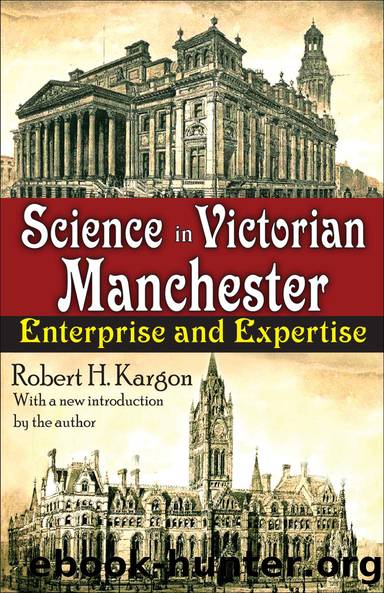Science in Victorian Manchester by William T. Golden

Author:William T. Golden [Golden, William T.]
Language: eng
Format: epub
ISBN: 9781351491884
Barnesnoble:
Publisher: Taylor & Francis
Published: 2017-07-05T00:00:00+00:00
Crace-Calvert and Industrial Chemistry
Spence, like Dale and Hart, signifies the subtle changes occurring in the Manchester community: increasingly after 1840 men engaged in science-based industry would begin to make the effect of their presence felt. Not only did Spence play an active role in the Lit. & Phil, (serving on its council) and the Mechanicsâ Institution but as chemical manufacturer offered employment, at least on a consulting basis, to the chemists of the city. Manchester was becoming by steps a comfortable home for chemical professionals. It is in this regard as well that the career of Frederick Crace-Calvert is significant, for Calvert, even more clearly than Smith, demonstrated that a chemist could make his way in Manchester.
Immediately upon his arrival in Manchester Crace-Calvert began to exhibit his phenomenal energy and wide-ranging chemical interests. Well trained by Chevreul in the chemistry of bleaching and dyeing, Crace-Calvert at once proceeded to secure his fortune. Supporting himself, while honorary professor at the Royal Manchester Institution, by teaching chemical classes, by lecturing, and by consulting for industrialists and local government, he systematically propagandized for chemistry. Again and again he would assure his audiences that the chemistry of today was not the âtheoretical chemistry of former times but was a science which enabled our manufacturers to improve their works and often even to make discoveries.â Not only was chemistry important for the âstaple trade of Manchester,â but also in order for Britons to âmaintain our position, the rising generation must study chemistry along with their mechanical trades.â Indeed, âit was only by the diffusion of science in every shape and form that it could be rendered useful in promoting the wealth and general good of humanity.â118
Like Playfair and Smith, Crace-Calvert would put his words into action. In his earliest days in Manchester, he turned his attention to what would naturally appear to be the most critical problems of the cityâs industryâthose relating to cotton. His papers during the first years concern bleaching and dyeing, the chemistry of mordants, and the action of chemicals on cotton. In 1850 he suggested certain improvements in the bleaching of linen which would reduce the six to twelve week duration to a mere three weeks: âI trust,â he stated, âthat the slight improvements I have made in the bleaching of linen will still be . . . brought to perfection; thus rendering available to Ireland and Scotland those thousands of acres of land which are now uselessly covered and by enabling them to bleach in winter as well as in summer, allow the manufacturers to renew their capital more rapidly.â119
Late in the 1840s, Crace-Calvertâs attention turned to carbolic acid in connection with his work on mordants. He found that it was tannic acid which produced black coloring with the use of iron mordants, and he explored the reaction with the mordants of gallic acid. He discovered that impure carbolic acid added to the extracts of tanning matters prevented, for several months, the tannin from turning into gallic acid, thus retaining the tannin extracts as commercially useful.
Download
This site does not store any files on its server. We only index and link to content provided by other sites. Please contact the content providers to delete copyright contents if any and email us, we'll remove relevant links or contents immediately.
Phoenicians among Others: Why Migrants Mattered in the Ancient Mediterranean by Denise Demetriou(584)
Verus Israel: Study of the Relations Between Christians and Jews in the Roman Empire, AD 135-425 by Marcel Simon(582)
Caesar Rules: The Emperor in the Changing Roman World (c. 50 BC â AD 565) by Olivier Hekster(565)
american english file 1 student book 3rd edition by Unknown(551)
Basic japanese A grammar and workbook by Unknown(514)
Europe, Strategy and Armed Forces by Sven Biscop Jo Coelmont(509)
Banned in the U.S.A. : A Reference Guide to Book Censorship in Schools and Public Libraries by Herbert N. Foerstel(474)
Give Me Liberty, Seventh Edition by Foner Eric & DuVal Kathleen & McGirr Lisa(472)
The Roman World 44 BC-AD 180 by Martin Goodman(466)
Reading Colonial Japan by Mason Michele;Lee Helen;(461)
DS001-THE MAN OF BRONZE by J.R.A(455)
The Dangerous Life and Ideas of Diogenes the Cynic by Jean-Manuel Roubineau(446)
Introducing Christian Ethics by Samuel Wells and Ben Quash with Rebekah Eklund(443)
Imperial Rome AD 193 - 284 by Ando Clifford(438)
The Oxford History of World War II by Richard Overy(437)
Literary Mathematics by Michael Gavin;(402)
Catiline by Henrik Ibsen--Delphi Classics (Illustrated) by Henrik Ibsen(397)
Language Hacking Mandarin by Benny Lewis & Dr. Licheng Gu(392)
How to Reach the 9.0 in IELTS Academic Reading by IELTS Medical(364)
